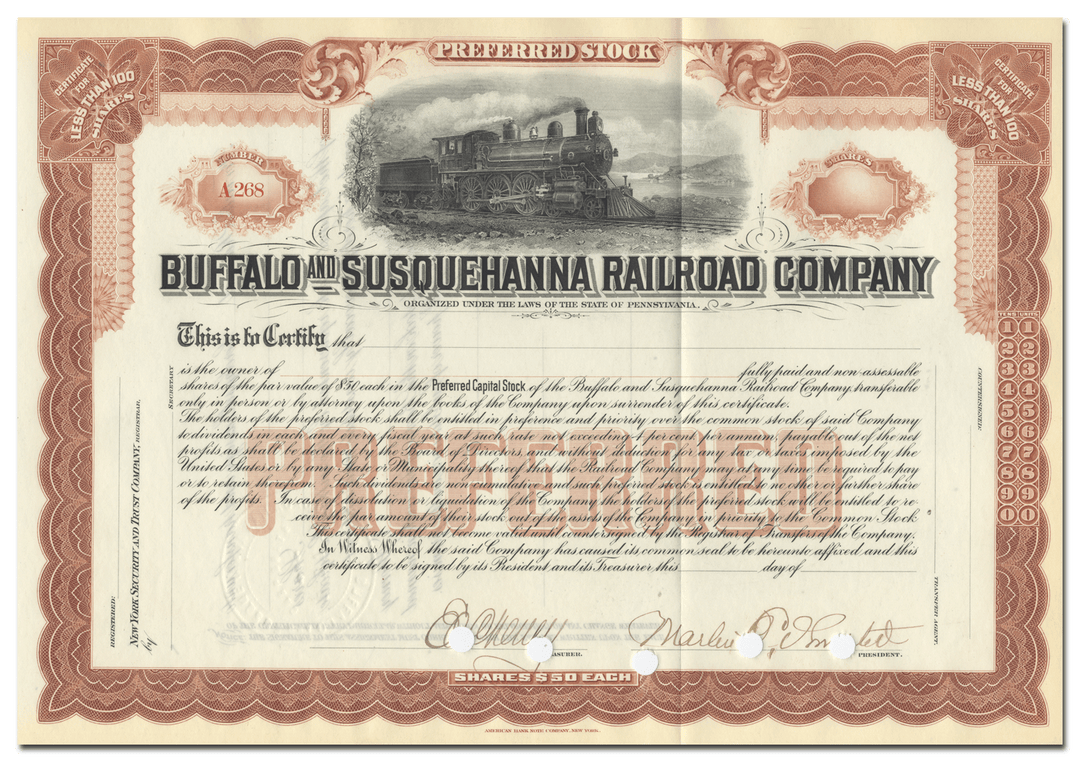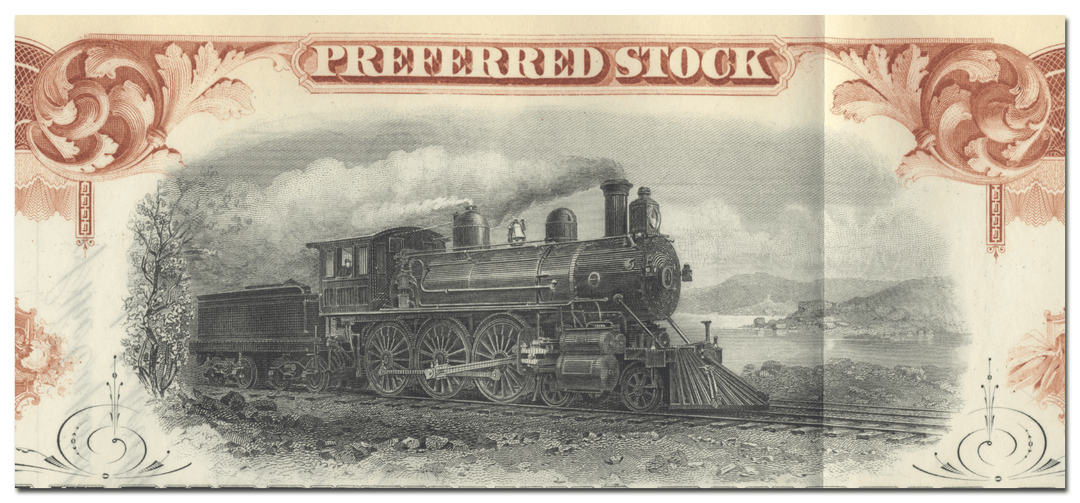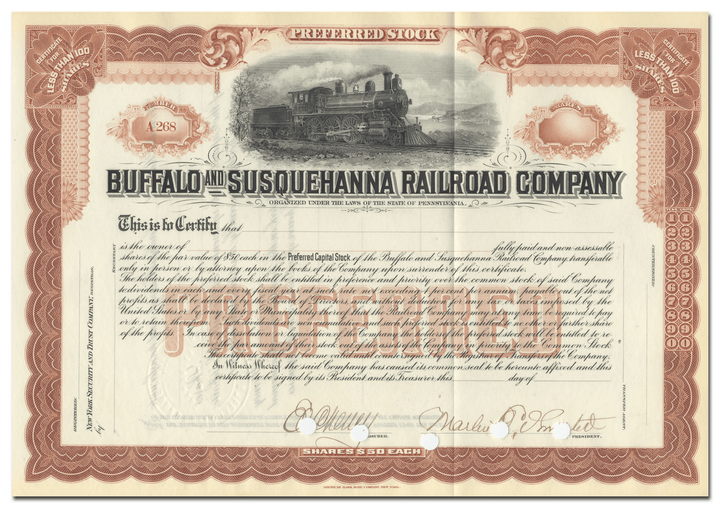Buffalo and Susquehanna Railroad Company
- Guaranteed authentic document
- Orders over $75 ship FREE to U. S. addresses
Product Details



Buffalo & Susquehanna Railroad Company
Certificate Type
Preferred Stock
Date Issued
Unissued, circa early 1900's
Canceled
Yes
Printer
American Bank Note Company
Signatures
Hand signed
Approximate Size
12 1/8" (w) by 8 1/2" (h)
Additional Details
NA
Historical Context

The Buffalo & Susquehanna was a regional railroad straddling the New York - Pennsylvania border. It was formed in 1885 when a Buffalo lumber a fuel dealer named Frank Goodyear bought an 8,000 acre tract of land in northern-central Pennsylvania. Frank Goodyear had retired in his 40's and purchased the land when he became bored with retirement. To extract the lumber from his new investment, he organized the Sinnemahoning Valley Railroad to run from Keating Summit on the Buffalo, New York & Philadelphia Railroad (later part of the Pennsylvania Railroad) to his sawmill in Austin, Pennsylvania. As the lumber and tanning business expanded, Frank Goodyear was joined by his brother Charles and more lines of various names were added to the east. In 1893 the lines reached Galeton and Ansonia, Pennsylvania and the lines were consolidated into the Buffalo & Susquehanna Railroad Company.
By New Years Day of 1896 the B&S ran trains the 37-miles from Galeton to Wellsville, New York. In 1898 the brothers purchased the Addison & Pennsylvania railroad running from Galeton, Pennsylvania to Addison, New York. The company began expanding the opposite direction and by 1900 was operating into Sinnemahoning, Pennsylvania where it connected to the Philadelphia & Erie Railroad (later part of the Pennsylvania system). South of Galeton the line ran through a series of switchbacks to climb the mountains. These switchbacks, later abandoned, limited the trains to 15 cars.
The Goodyear lumber and coal empire flourished and the railroad ran spurs and branch lines up almost every creek and valley in the area. Numerous related companies were formed, including the Goodyear Lumber Company and Lackawanna Lumber Company which by 1902 reported more than 140 miles of spurs. As coal and lumber supplies were exhausted in one area the track was pulled up and laid in another.
To get their coal and lumber to market, the Goodyears built the Buffalo & Susquehanna Railway north from Wellsville to Buffalo. This line was completed in 1906 and linked the coal and timber lands to the ships of the Buffalo & Susquehanna Steamship Company in Buffalo. At it's height, the railroad ran 250 miles from Buffalo to Sagamore, Pennsylvania and had more than 400 miles of track. Logging railroads using geared locomotives hauled lumber to the Goodyear mills which cut it and shipped it out over the B&S. Coal and coke from the south end of the system generated considerable revenue, as did the operation of numerous tanneries along the line, including the one at Costello, New York which was reported at the time to be the largest in the world.
Unfortunately, the boom turned quickly to a bust and the Goodyear family and the B&S had a sudden reversal of fortune. Frank Goodyear died in 1907 precipitating a crisis. Shortly after the Buffalo & Susquehanna Railway (Buffalo to Wellsville) leased the Buffalo & Susquehanna Railroad (the rest of the system) and operated the whole as the Buffalo & Susquehanna Railway. The company was financially troubled and in 1910 H. I. Miller, who had been president of another Goodyear family railroad, the New Orleans Great Northern, was appointed receiver for both the railway and railroad. In 1913 the Buffalo & Susquehanna Railroad Corporation was formed. Only eight years after being built, New York Supreme Court Justice, and formed law partner of Charles Goodyear, H. P. Bissel ruled that the Buffalo to Wellsville line should be torn up for lack of traffic. All the rail, bridges and other steel were sold to the French in 1916 for a substantial sum due to the demand for steel created by WWI.
H. I. Miller continued to operate the rest of the line as chairman of the board until 1932 when it was purchased by the >Baltimore & Ohio Railroad.
In July 1942 a flood washed out the track south of Galeton leaving the rest of the former B&S separated from the B&O. In 1954 the B&O merged the B&S with two smaller railroads it had leased since the turn of the century. In 1956 the Wellsville - Addison - Galeton section was sold to Murray Salzberg who operated it as the Wellsville, Addison & Galeton Railroad until the WAG's demise in 1979.
Related Collections
Additional Information
Certificates carry no value on any of today's financial indexes and no transfer of ownership is implied. All items offered are collectible in nature only. So, you can frame them, but you can't cash them in!
All of our pieces are original - we do not sell reproductions. If you ever find out that one of our pieces is not authentic, you may return it for a full refund of the purchase price and any associated shipping charges.









